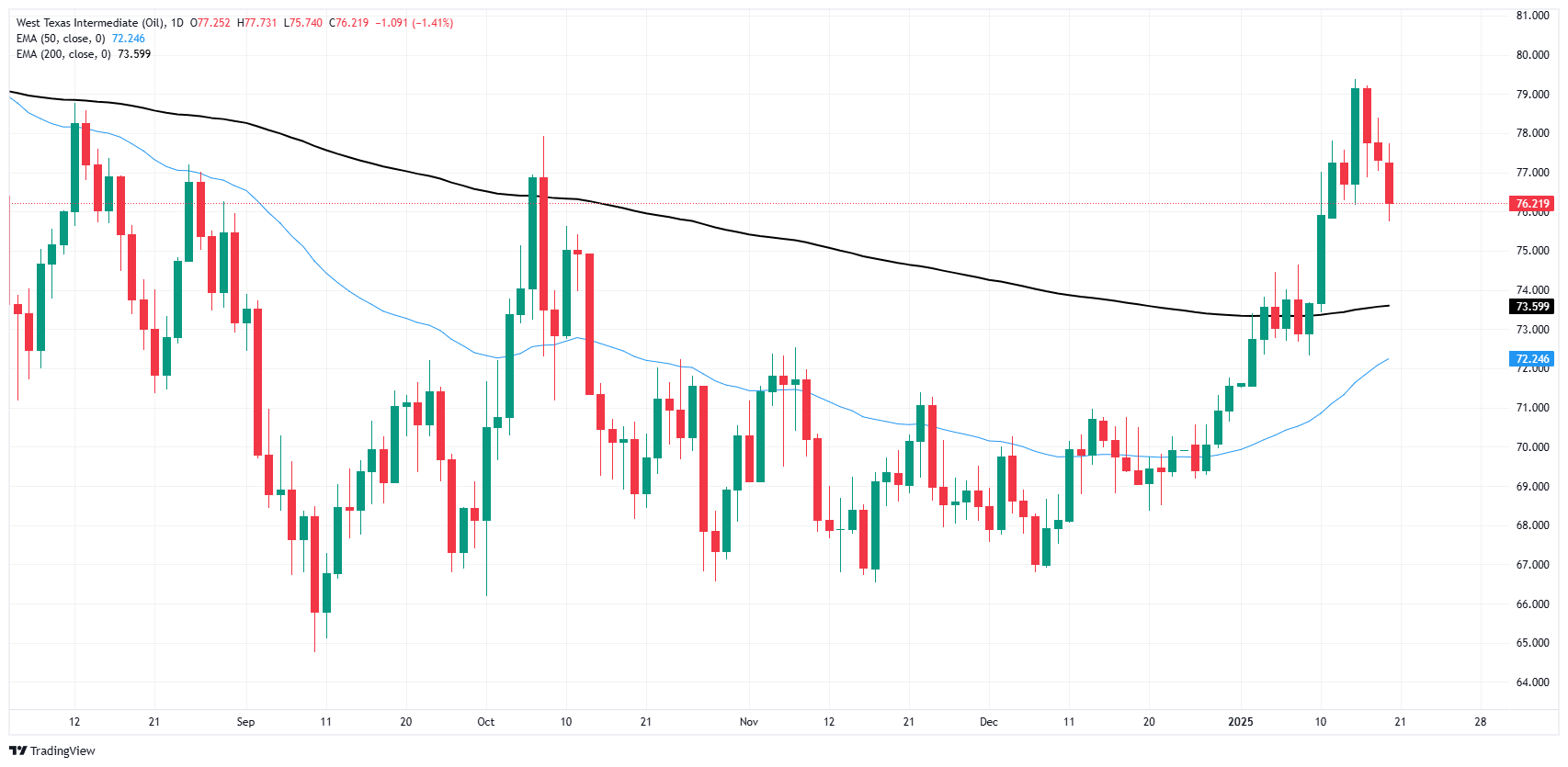Crude Oil takes a knee for a third straight day, WTI taps $76
- Crude Oil markets eased for a third consecutive trading day.
- Monday sees further price declines in fossil fuel barrels.
- US production growth is expected to continue slowing.
West Texas Intermediate (WTI) Crude Oil prices eased for a third straight session on Monday, kicking off the new trading week with a fresh test of the $76/bbl handle. Despite newly-minted President Donald Trump’s insistence that he’s going to create a mandate that will push US Crude Oil producers to ramp up production, slowing growth in that exact space remains subdued as energy producers focus on returning profits to investors instead of going broke on behalf of the US government.
Despite lofty promises from the new US administration, major financial institutions are bracing for Crude Oil prices to continue easing moving forward. Median forecasts are predicting WTI barrel bids will sink to below $60 per barrel by the halfway point of President Donald Trump’s term. Global demand continues to undershoot lofty expectations that were set in 2023 and 2024, and investors are scrambling to walk back their expectations of global demand for energy that has thus far failed to materialize, specifically in mainland China despite the country perfectly nailing overall economic growth mandates established by the government, almost to a suspicious degree.
Crude Oil price forecast
After spending most of the fourth quarter battling it out in a rough technical range cycling the $69.00 handle, WTI prices surged to kick off the 2025 trading season, peaking a little over $79.00 per barrel. US Crude Oil bidding action has eased off the pedal, capping gains and chalking in a three-day losing streak as price action falls back toward the 200-day Exponential Moving Average (EMA) near $73.50.
Despite a near-term swing into a pattern of higher lows, a lack of a sustained pullback and ongoing bullish momentum means 2025’s early bull action could run out of runway and snap back into the low side. The 50-day EMA still remains physically below the 200-day EMA, and a lack of a meaningful crossover of the two key MAs could leave bears open for a chance to take another leg lower.
WTI daily chart
WTI Oil FAQs
WTI Oil is a type of Crude Oil sold on international markets. The WTI stands for West Texas Intermediate, one of three major types including Brent and Dubai Crude. WTI is also referred to as “light” and “sweet” because of its relatively low gravity and sulfur content respectively. It is considered a high quality Oil that is easily refined. It is sourced in the United States and distributed via the Cushing hub, which is considered “The Pipeline Crossroads of the World”. It is a benchmark for the Oil market and WTI price is frequently quoted in the media.
Like all assets, supply and demand are the key drivers of WTI Oil price. As such, global growth can be a driver of increased demand and vice versa for weak global growth. Political instability, wars, and sanctions can disrupt supply and impact prices. The decisions of OPEC, a group of major Oil-producing countries, is another key driver of price. The value of the US Dollar influences the price of WTI Crude Oil, since Oil is predominantly traded in US Dollars, thus a weaker US Dollar can make Oil more affordable and vice versa.
The weekly Oil inventory reports published by the American Petroleum Institute (API) and the Energy Information Agency (EIA) impact the price of WTI Oil. Changes in inventories reflect fluctuating supply and demand. If the data shows a drop in inventories it can indicate increased demand, pushing up Oil price. Higher inventories can reflect increased supply, pushing down prices. API’s report is published every Tuesday and EIA’s the day after. Their results are usually similar, falling within 1% of each other 75% of the time. The EIA data is considered more reliable, since it is a government agency.
OPEC (Organization of the Petroleum Exporting Countries) is a group of 12 Oil-producing nations who collectively decide production quotas for member countries at twice-yearly meetings. Their decisions often impact WTI Oil prices. When OPEC decides to lower quotas, it can tighten supply, pushing up Oil prices. When OPEC increases production, it has the opposite effect. OPEC+ refers to an expanded group that includes ten extra non-OPEC members, the most notable of which is Russia.


